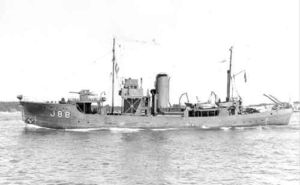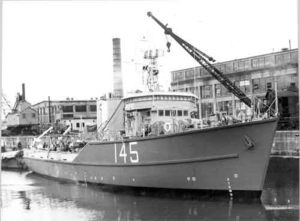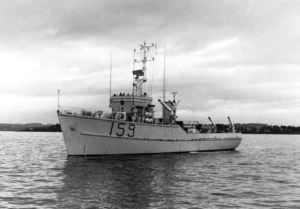OFFICIAL HISTORIES OF
HMCS FUNDY (pennants J-88), commissioned 2 September, 1938, had been in service exactly one year when the Second World War began. First of the name, she had been launched at Collingwood, Ontario, on 18 June, 1938. One of the four “Basset” Class minesweepers with which Canada entered the war, FUNDY, together with her sister-ship HMCS GASPE, was immediately assigned to local patrol and minesweeping duty in the approaches to Halifax Harbour. These two ships formed the nucleus of the Halifax Local Defence Force, which was augmented throughout the war years by a varied assortment of auxiliary craft, pressed into service by the urgency of the situation. Upon this heterogeneous force fell the responsibility of guarding the waters off Chebucto Head commanding Canada’s major East Coast port.
FUNDY served throughout the entire period of the war on local duty out of Halifax. Faithfully the sturdy, 690-ton vessel dragged her sweeps up and down the marked channels, always alert, always on the lookout for trouble, and rarely finding any. Invariably her Commanding Officer closed his report at the end of the day’s sweep with the brief notation: “No mines were found.”
Only once, in six years of war, were enemy mines laid off Halifax. Early in June 1943, it was discovered that some 55 to 60 moored magnetic mines ringed the harbour entrance. FUNDY who had long looked forward to such a challenge, was in refit at Shelburne. Upon completion on 6 June, she sailed at once for Halifax where she took up her duties along with RCN Bangors and the Royal Navy’s 122nd Motor Minesweeping Flotilla.
If, however, she had scant opportunity for grappling with the enemy at first hand, there were other vitally important jobs for her to do. Not the least of these was the rescue of survivors from torpedo merchantmen. With HMCS COMOX in January 1945, FUNDY succeeded in picking up all 66 survivors of the torpedoed American freighter SS Martin Van Buren.
Whatever the doughty little ‘sweeper was called upon to do by the exigencies of the moment and the hard-pressed demands of the fleet, FUNDY, and the men who served in her, turned to with a will. By such devotion to duty, and unceasing vigilance, was the war at sea ultimately won.
Being a coal-burning ship, HMCS FUNDY was considered obsolete by the close of the Second World War. On 27 July, 1945, at Sorel, P.Q., the minesweeper was turned over to War Assets Corporation for disposal. At last report, 9 October, 1957, the old ship was still lying at her berth at Sorel.
HMCS FUNDY, second of name, had a very brief career under the White Ensign of the Royal Canadian Navy. She too was a minesweeper but of very different construction to that of her predecessor. Of the “Bay” Class, the 152-foot ship was built of wood and aluminIum to comply with modern concepts of mine warfare. Built at Saint John, N.B., she was commissioned there on 19 March, 1954. HMCS FUNDY was sailed to Halifax and there joined the First Canadian Minesweeping Squadron. However, her pennants, MCB-145, were not to be seen for long in Canadian waters.
In compliance with Canadian foreign policy of mutual aid to our partners in the North Atlantic Treaty Organization, HMCS FUNDY, together with other ships of her class, was transferred to France. At Halifax on 7 April after only eighteen days service, the French Tricolour was hoisted in the FUNDY and she was given her new name La Dunkerquoise.
HMCS FUNDY, pennants MCB-159 and third of name, is another minesweeper of the “Bay” Class as is presently a member of the First Canadian Minesweeping Squadron, based on Halifax. Built at Lauzon, P.Q., she was launched on the St. Lawrence 14 June, 1956, and was commissioned in the Royal Canadian Navy on 27 November the same year.
HMCS FUNDY has been awarded the following Battle Honour for service in the Second World War:
- ATLANTIC, 1939-45.




 CFB Esquimalt Naval and Military Museum
CFB Esquimalt Naval and Military Museum
 CFB Esquimalt Naval and Military Museum
CFB Esquimalt Naval and Military Museum CFB Esquimalt Naval and Military Museum
CFB Esquimalt Naval and Military Museum CFB Esquimalt Naval and Military Museum
CFB Esquimalt Naval and Military Museum CFB Esquimalt Naval and Military Museum
CFB Esquimalt Naval and Military Museum CFB Esquimalt Naval and Military Museum
CFB Esquimalt Naval and Military Museum CFB Esquimalt Naval and Military Museum
CFB Esquimalt Naval and Military Museum CFB Esquimalt Naval and Military Museum
CFB Esquimalt Naval and Military Museum CFB Esquimalt Naval and Military Museum
CFB Esquimalt Naval and Military Museum CFB Esquimalt Naval and Military Museum
CFB Esquimalt Naval and Military Museum CFB Esquimalt Naval and Military Museum
CFB Esquimalt Naval and Military Museum CFB Esquimalt Naval and Military Museum
CFB Esquimalt Naval and Military Museum
 CFB Esquimalt Naval and Military Museum
CFB Esquimalt Naval and Military Museum CFB Esquimalt Naval and Military Museum
CFB Esquimalt Naval and Military Museum CFB Esquimalt Naval and Military Museum
CFB Esquimalt Naval and Military Museum CFB Esquimalt Naval and Military Museum
CFB Esquimalt Naval and Military Museum CFB Esquimalt Naval and Military Museum
CFB Esquimalt Naval and Military Museum CFB Esquimalt Naval and Military Museum
CFB Esquimalt Naval and Military Museum CFB Esquimalt Naval and Military Museum
CFB Esquimalt Naval and Military Museum CFB Esquimalt Naval and Military Museum
CFB Esquimalt Naval and Military Museum CFB Esquimalt Naval and Military Museum
CFB Esquimalt Naval and Military Museum CFB Esquimalt Naval and Military Museum
CFB Esquimalt Naval and Military Museum

 CFB Esquimalt Naval and Military Museum
CFB Esquimalt Naval and Military Museum CFB Esquimalt Naval and Military Museum
CFB Esquimalt Naval and Military Museum CFB Esquimalt Naval and Military Museum
CFB Esquimalt Naval and Military Museum CFB Esquimalt Naval and Military Museum
CFB Esquimalt Naval and Military Museum CFB Esquimalt Naval and Military Museum
CFB Esquimalt Naval and Military Museum
 CFB Esquimalt Naval and Military Museum
CFB Esquimalt Naval and Military Museum



 CFB Esquimalt Naval and Military Museum
CFB Esquimalt Naval and Military Museum



































 CFB Esquimalt Naval and Military Museum
CFB Esquimalt Naval and Military Museum CFB Esquimalt Naval and Military Museum
CFB Esquimalt Naval and Military Museum
 CFB Esquimalt Naval and Military Museum
CFB Esquimalt Naval and Military Museum